On August 11th, a six SCUBAnauts from two chapters were able to participate in a Science Research Day put together by Carlie Williams, the Education Officer from the Tarpon Springs chapter.
The goal of SciDay was to show the ‘nauts some of the many different research projects going on in the Marine Science cluster in downtown St. Petersburg. St. Pete hosts an amazing number of marine science-focused agencies. These include USF College of Marine Science (many of our valuable volunteers are graduate students there!), the Florida Wildlife Research Institute (FWRI), U.S. Geological Survey Coastal and Marine Science Center (USGS). The scientists at these agencies are involved in a huge range of experiments such as biology, geology, ecology and much more.
The ‘nauts got the chance to learn from these researchers and see their personal projects.
First up was a presentation by Maria Vega-Rodriguez on how she uses satellites in her research. Remote sensing is a very useful resource for oceanographers, allowing them to access data about the ocean on a very large scale and over long time periods. The satellites can measure a lot of things including ocean color (indicating how much chlorophyll is in the water, measuring plankton blooms) and sea surface temperature. Sea surface temperature can be used to track currents or even help Maria to predict when coral bleaching might occur. After learning about remote sensing, the ‘nauts got the chance to build their own spectroscopes, a simple method for separating light into it’s basic wavelengths.
The ‘nauts make their own spectroscopes which demonstrate that visible light can be broken down into parts (like a rainbow)
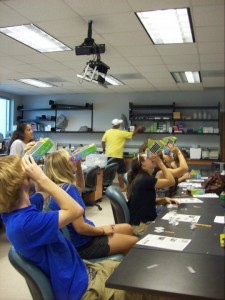 |
| A picture of the ‘nauts testing out their spectroscopes. |
Sennai Habtes led a great activity where the ‘nauts used a net to do a plankton tow. Plankton are any living organisms that can’t swim against the current, and are made up tiny little plants (phytoplankton) and little animals (zooplankton). Many zooplankton are actually the baby larvae of bigger fish and animals that we like to eat (like tuna and lobster), so it’s really important to know what’s out there. The ‘nauts were able to do their own plankton tows and then check out their plankton under the microscope. Sennai challenged the ‘nauts to identify their plankton, and it was definitely difficult!
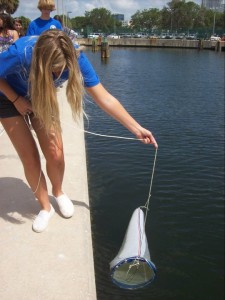 |
| Ashley towing the plankton net along the seawall |
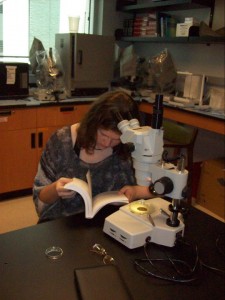 |
| Sheridan checking out some plankton underneath a dissecting microscope. She’s using a book about the plankton of the Gulf of Mexico to help her identify what she sees. |
After lunch, the ‘nauts visited a microbiology lab to learn how marine scientists use DNA in their research. Bacteria and viruses form the basis for many chemical reactions in the ocean, feed or cause disease in other organisms. The DNA in these microbes can tell us a lot what they are and what they do in the oceans because they’re too small to see and hard to work with in the lab. Dr. Lauren McDaniel demonstrated how to extract DNA from a sample. After the ‘nauts learned how to get DNA out of the cells, Dr. McDaniel showed them how to visualize the DNA to see its quality and quantity.
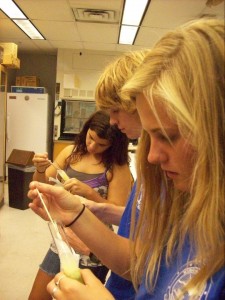 |
| Pulling out extracted DNA (the white stuff) with a Q-tip |
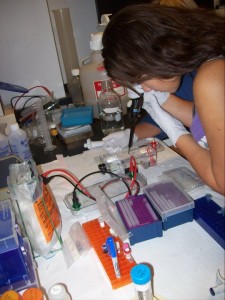 |
| Loading DNA into a gel to test the quality and size of it.
Stay tuned for Part 2! |

